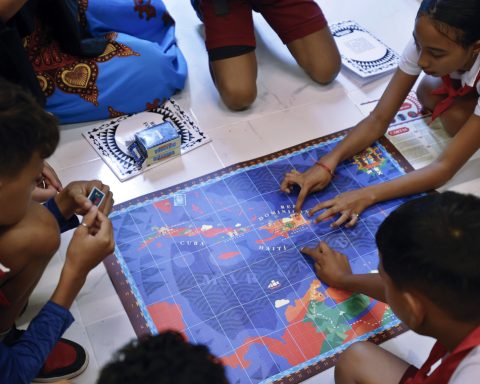SANTIAGO DE CUBA.- “It is incredible that since 2010 not even the painting has changed. It even looks worse than 12 years ago.” That was the first impression that Mirian Gutiérrez had when she arrived at the emergency room of the South Children’s Hospital, known as La Colonia, in Santiago de Cuba. His three-month-old baby had an acute case of diarrhea and fever, for which he was referred on the 19th from his health center in the Songo La Maya municipality, where he lives.
“It was around 11 a.m. when I took the referral from the Polyclinic doctor to go on my own, because I had been with the child since 8 a.m. and the ambulance did not show up. My husband rented a car and we arrived at the Hospital at noon. As expected, the guard room was full, and there was only one doctor to attend to all of us.”
Fortunately, the baby was taken care of in a short time because he is still nursing and has a certain priority among the other children. But that luck did not have the majority, because that day there were no reagents to carry out blood counts, nor medicines to treat patients. According to Miriam, when her parents complained, the doctor only repeated that she “couldn’t do anything else.”
Taking into account the picture presented by the child, the doctor explained to the woman that they should admit him immediately because he could easily become dehydrated, also because that age is considered high risk. She then told him that they would put him in the Gastro room because she was small, quiet and she “had all the conditions created for the stay of little children like hers.”

However, Mirian’s expectations crumbled as soon as she reached said room. There she was received by a doctor who told her that she should possibly stay for five days, since the baby would need to take a course of antibiotics since the diarrhea was of bacterial origin. It should be noted that her diagnosis was based only on her symptoms, since at no time did she undergo tests.
“Since I entered the room, everything seemed old and dirty. Immediately, the doctor, very affectionate by the way, read me a regulation in which she warned me that we could not leave the cubicle because there were children with infectious diseases that could complicate my son. So they put me in the first one, where there was only a kind of cradle, an armchair and a small metal table. The truth is all very disastrous”, she explained to CubaNet.
Also, Mirian described, that room was tiny and had a single window almost two meters from the floor, so not even a breeze entered. The crib, with iron bars, was covered with worn and yellowed sheets; and the armchair, where she had to sleep all those days, “seemed to be from another century” because of its dilapidation.
Images of the bathroom where mothers have to bathe their babies. courtesy photo
Images of the bathroom where mothers have to bathe their babies. courtesy photo
“Right next to my room was the bathroom, unfortunately for me. Not only did it gross me out because of the stink and filth, but because it stayed wet due to a leak in the toilet. There was also nowhere to bathe the children. Every day I had to hold him on top of me to clean him. That was a real hell ”she commented indignantly.
In addition, to get hot water, the mothers had to go out to get it from a boiler, which was actually an iron tank raised from the ground connected to another device. Every once in a while Mirian went to look for her, and she always had to leave the baby alone, since the nurses hardly ever went through the cubicles.

Another constant odyssey in the hospital was milk, some children only fed from the mother, but others, like the little one from Gutiérrez, take formula in a complementary way. The woman told her that on three occasions she cut off the milk they gave her at night, and her son was left alone with the breast until the next day. The problem, she says, is that it’s made in the morning, and obviously it can’t keep for long outside the fridge.
“The refrigerator there only worked the freezer. Therefore, the milk could not be stored, and it was soon cut off. One night I gave my son half sour milk because he was crying and I was desperate. I had nothing else to do, because since I was two months old I barely have a little in my breasts and I had to give it a powder, ”lamented the mother.

At least Mirian was visited by her relatives from time to time, and they brought her what she needed. Rachel Heredia, also from La Maya, was admitted with her daughter to this hospital last month, with a similar diagnosis. According to what she told CubaNet, her experience was one of the most bitter since she only drank water and ate cookies with jam for seven days.
“The food they gave to the companions there was disgusting. I made an effort to eat it, but I couldn’t, it made me want to vomit. The smell alone made me sick. My mother is bedridden and the girl’s father lives in Havana, so he didn’t have anyone to see me, ”explained the young woman.

Heredia claimed to have bathed her daughter in a bucket that she brought from home and in that same bucket she was forced to wash the diapers, and even to wash the bottles. “My experience in the hospital was the worst. I never want to go through the same thing again, ”she concluded.
Regarding the treatment for bacterial diarrhea, that same afternoon they began to give the baby intramuscular Ceftriaxone (Rosefin), in doses of two cc daily; without first performing an antibiogram to find out what bacteria it was and which antibiotic was the most indicated. The other therapies were symptomatic, that is, dipyrone in case of fever and oral rehydration salts after each diarrhea.

For Dr. Roberto Serrano Delis, carrying out a sensitivity test in a Cuban hospital at the moment is, to say the least, unsuccessful, because there are rarely varieties of antibiotics. In almost all cases, Rosefin is used, which is a third-generation antibiotic with a broad spectrum against gram-negative and gram-positive bacteria.
Receive information from CubaNet on your cell phone through WhatsApp. Send us a message with the word “CUBA” on the phone +525545038831, You can also subscribe to our electronic newsletter by giving click here.




















